Business Strategy Report: External-Environmental Analysis of Nestle
VerifiedAdded on 2023/05/29
|5
|1089
|172
Report
AI Summary
This report provides a comprehensive external-environmental analysis of Nestle, a global food and beverage company. It utilizes the PESTLE framework to examine political, economic, social, and technological factors influencing Nestle's operations. The report also applies Porter's Five Forces model to assess the competitive landscape, including rivalry, new entrants, supplier power, buyer power, and substitute products. Furthermore, it incorporates strategic group mapping to compare Nestle with its competitors, such as Unilever and Danone, based on factors like price range and geographical locations. The analysis highlights key challenges like product recalls, foreign exchange fluctuations, and changing consumer preferences towards healthier options. The report concludes by assessing Nestle's competitive advantage and strategic positioning within the food and beverage industry, providing insights into its business strategy and market dynamics.
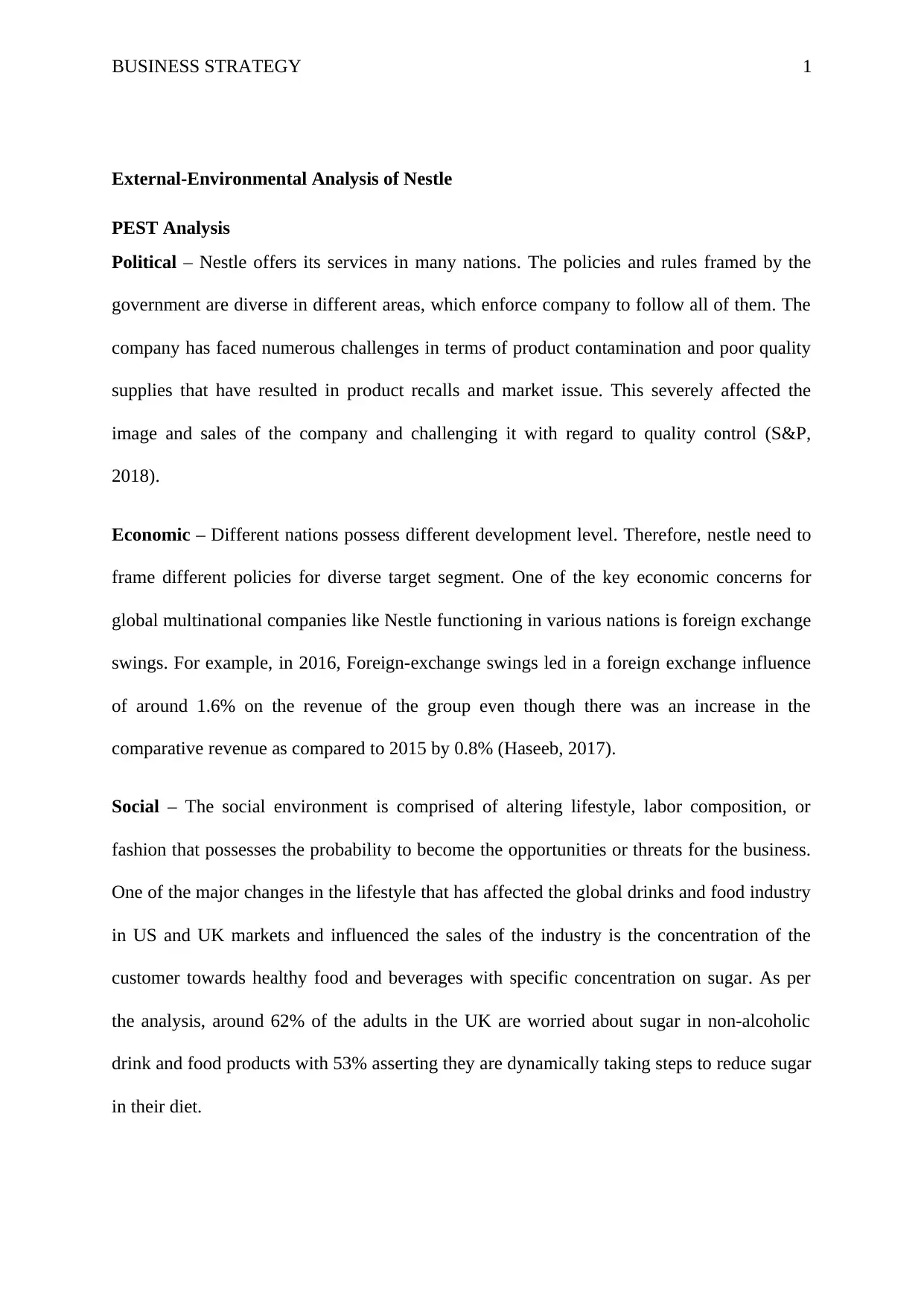
BUSINESS STRATEGY 1
External-Environmental Analysis of Nestle
PEST Analysis
Political – Nestle offers its services in many nations. The policies and rules framed by the
government are diverse in different areas, which enforce company to follow all of them. The
company has faced numerous challenges in terms of product contamination and poor quality
supplies that have resulted in product recalls and market issue. This severely affected the
image and sales of the company and challenging it with regard to quality control (S&P,
2018).
Economic – Different nations possess different development level. Therefore, nestle need to
frame different policies for diverse target segment. One of the key economic concerns for
global multinational companies like Nestle functioning in various nations is foreign exchange
swings. For example, in 2016, Foreign-exchange swings led in a foreign exchange influence
of around 1.6% on the revenue of the group even though there was an increase in the
comparative revenue as compared to 2015 by 0.8% (Haseeb, 2017).
Social – The social environment is comprised of altering lifestyle, labor composition, or
fashion that possesses the probability to become the opportunities or threats for the business.
One of the major changes in the lifestyle that has affected the global drinks and food industry
in US and UK markets and influenced the sales of the industry is the concentration of the
customer towards healthy food and beverages with specific concentration on sugar. As per
the analysis, around 62% of the adults in the UK are worried about sugar in non-alcoholic
drink and food products with 53% asserting they are dynamically taking steps to reduce sugar
in their diet.
External-Environmental Analysis of Nestle
PEST Analysis
Political – Nestle offers its services in many nations. The policies and rules framed by the
government are diverse in different areas, which enforce company to follow all of them. The
company has faced numerous challenges in terms of product contamination and poor quality
supplies that have resulted in product recalls and market issue. This severely affected the
image and sales of the company and challenging it with regard to quality control (S&P,
2018).
Economic – Different nations possess different development level. Therefore, nestle need to
frame different policies for diverse target segment. One of the key economic concerns for
global multinational companies like Nestle functioning in various nations is foreign exchange
swings. For example, in 2016, Foreign-exchange swings led in a foreign exchange influence
of around 1.6% on the revenue of the group even though there was an increase in the
comparative revenue as compared to 2015 by 0.8% (Haseeb, 2017).
Social – The social environment is comprised of altering lifestyle, labor composition, or
fashion that possesses the probability to become the opportunities or threats for the business.
One of the major changes in the lifestyle that has affected the global drinks and food industry
in US and UK markets and influenced the sales of the industry is the concentration of the
customer towards healthy food and beverages with specific concentration on sugar. As per
the analysis, around 62% of the adults in the UK are worried about sugar in non-alcoholic
drink and food products with 53% asserting they are dynamically taking steps to reduce sugar
in their diet.
Paraphrase This Document
Need a fresh take? Get an instant paraphrase of this document with our AI Paraphraser
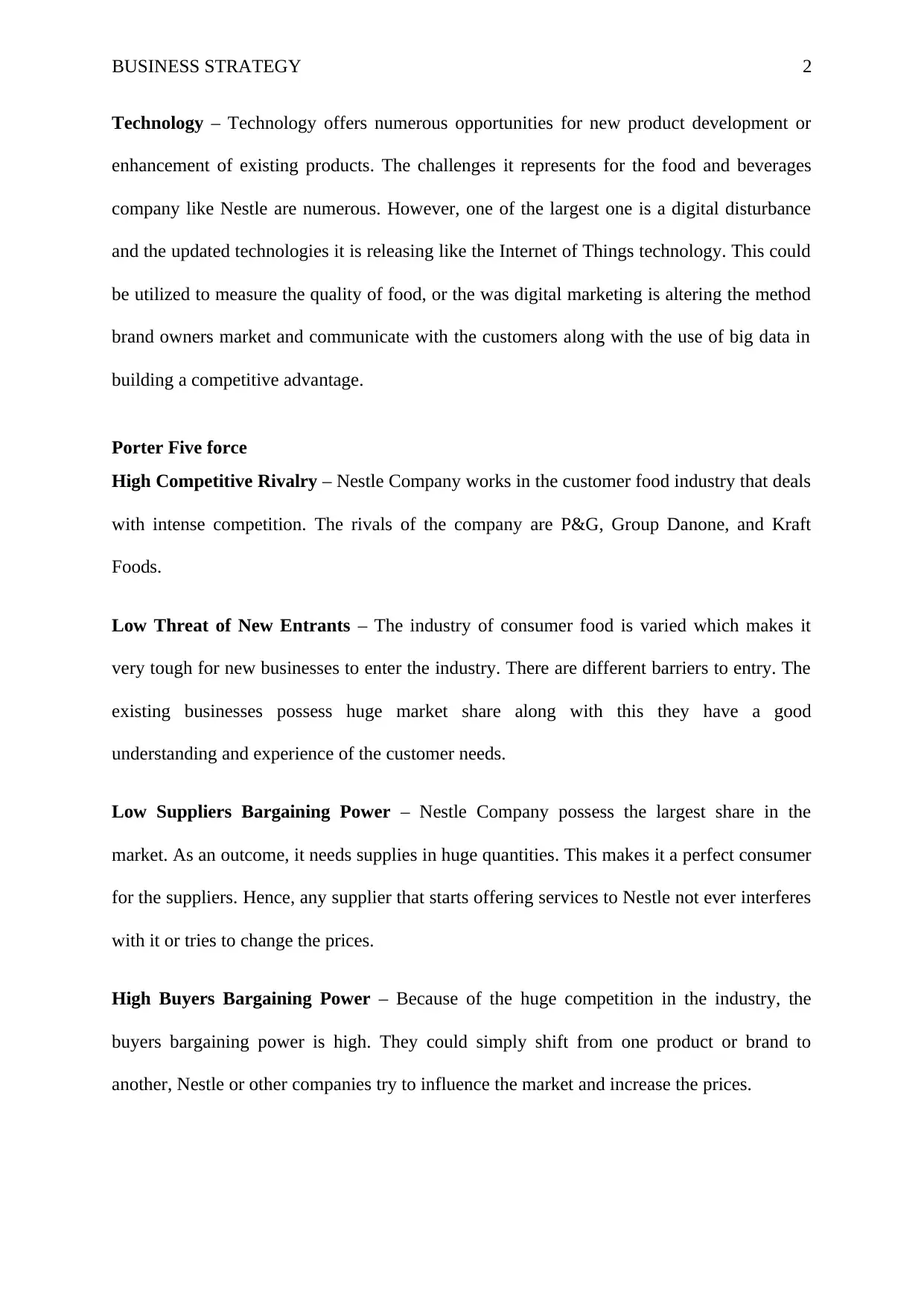
BUSINESS STRATEGY 2
Technology – Technology offers numerous opportunities for new product development or
enhancement of existing products. The challenges it represents for the food and beverages
company like Nestle are numerous. However, one of the largest one is a digital disturbance
and the updated technologies it is releasing like the Internet of Things technology. This could
be utilized to measure the quality of food, or the was digital marketing is altering the method
brand owners market and communicate with the customers along with the use of big data in
building a competitive advantage.
Porter Five force
High Competitive Rivalry – Nestle Company works in the customer food industry that deals
with intense competition. The rivals of the company are P&G, Group Danone, and Kraft
Foods.
Low Threat of New Entrants – The industry of consumer food is varied which makes it
very tough for new businesses to enter the industry. There are different barriers to entry. The
existing businesses possess huge market share along with this they have a good
understanding and experience of the customer needs.
Low Suppliers Bargaining Power – Nestle Company possess the largest share in the
market. As an outcome, it needs supplies in huge quantities. This makes it a perfect consumer
for the suppliers. Hence, any supplier that starts offering services to Nestle not ever interferes
with it or tries to change the prices.
High Buyers Bargaining Power – Because of the huge competition in the industry, the
buyers bargaining power is high. They could simply shift from one product or brand to
another, Nestle or other companies try to influence the market and increase the prices.
Technology – Technology offers numerous opportunities for new product development or
enhancement of existing products. The challenges it represents for the food and beverages
company like Nestle are numerous. However, one of the largest one is a digital disturbance
and the updated technologies it is releasing like the Internet of Things technology. This could
be utilized to measure the quality of food, or the was digital marketing is altering the method
brand owners market and communicate with the customers along with the use of big data in
building a competitive advantage.
Porter Five force
High Competitive Rivalry – Nestle Company works in the customer food industry that deals
with intense competition. The rivals of the company are P&G, Group Danone, and Kraft
Foods.
Low Threat of New Entrants – The industry of consumer food is varied which makes it
very tough for new businesses to enter the industry. There are different barriers to entry. The
existing businesses possess huge market share along with this they have a good
understanding and experience of the customer needs.
Low Suppliers Bargaining Power – Nestle Company possess the largest share in the
market. As an outcome, it needs supplies in huge quantities. This makes it a perfect consumer
for the suppliers. Hence, any supplier that starts offering services to Nestle not ever interferes
with it or tries to change the prices.
High Buyers Bargaining Power – Because of the huge competition in the industry, the
buyers bargaining power is high. They could simply shift from one product or brand to
another, Nestle or other companies try to influence the market and increase the prices.
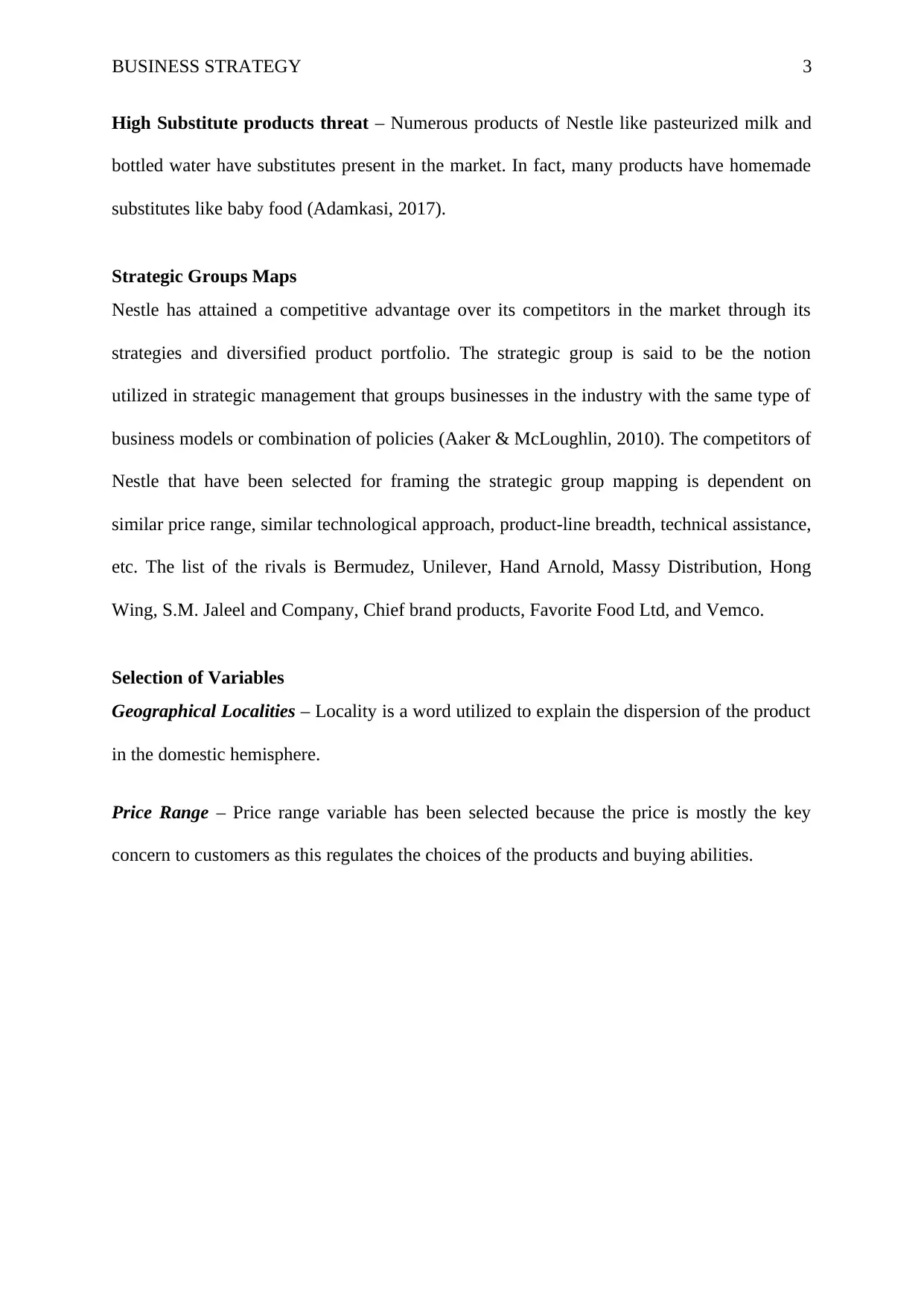
BUSINESS STRATEGY 3
High Substitute products threat – Numerous products of Nestle like pasteurized milk and
bottled water have substitutes present in the market. In fact, many products have homemade
substitutes like baby food (Adamkasi, 2017).
Strategic Groups Maps
Nestle has attained a competitive advantage over its competitors in the market through its
strategies and diversified product portfolio. The strategic group is said to be the notion
utilized in strategic management that groups businesses in the industry with the same type of
business models or combination of policies (Aaker & McLoughlin, 2010). The competitors of
Nestle that have been selected for framing the strategic group mapping is dependent on
similar price range, similar technological approach, product-line breadth, technical assistance,
etc. The list of the rivals is Bermudez, Unilever, Hand Arnold, Massy Distribution, Hong
Wing, S.M. Jaleel and Company, Chief brand products, Favorite Food Ltd, and Vemco.
Selection of Variables
Geographical Localities – Locality is a word utilized to explain the dispersion of the product
in the domestic hemisphere.
Price Range – Price range variable has been selected because the price is mostly the key
concern to customers as this regulates the choices of the products and buying abilities.
High Substitute products threat – Numerous products of Nestle like pasteurized milk and
bottled water have substitutes present in the market. In fact, many products have homemade
substitutes like baby food (Adamkasi, 2017).
Strategic Groups Maps
Nestle has attained a competitive advantage over its competitors in the market through its
strategies and diversified product portfolio. The strategic group is said to be the notion
utilized in strategic management that groups businesses in the industry with the same type of
business models or combination of policies (Aaker & McLoughlin, 2010). The competitors of
Nestle that have been selected for framing the strategic group mapping is dependent on
similar price range, similar technological approach, product-line breadth, technical assistance,
etc. The list of the rivals is Bermudez, Unilever, Hand Arnold, Massy Distribution, Hong
Wing, S.M. Jaleel and Company, Chief brand products, Favorite Food Ltd, and Vemco.
Selection of Variables
Geographical Localities – Locality is a word utilized to explain the dispersion of the product
in the domestic hemisphere.
Price Range – Price range variable has been selected because the price is mostly the key
concern to customers as this regulates the choices of the products and buying abilities.
⊘ This is a preview!⊘
Do you want full access?
Subscribe today to unlock all pages.

Trusted by 1+ million students worldwide
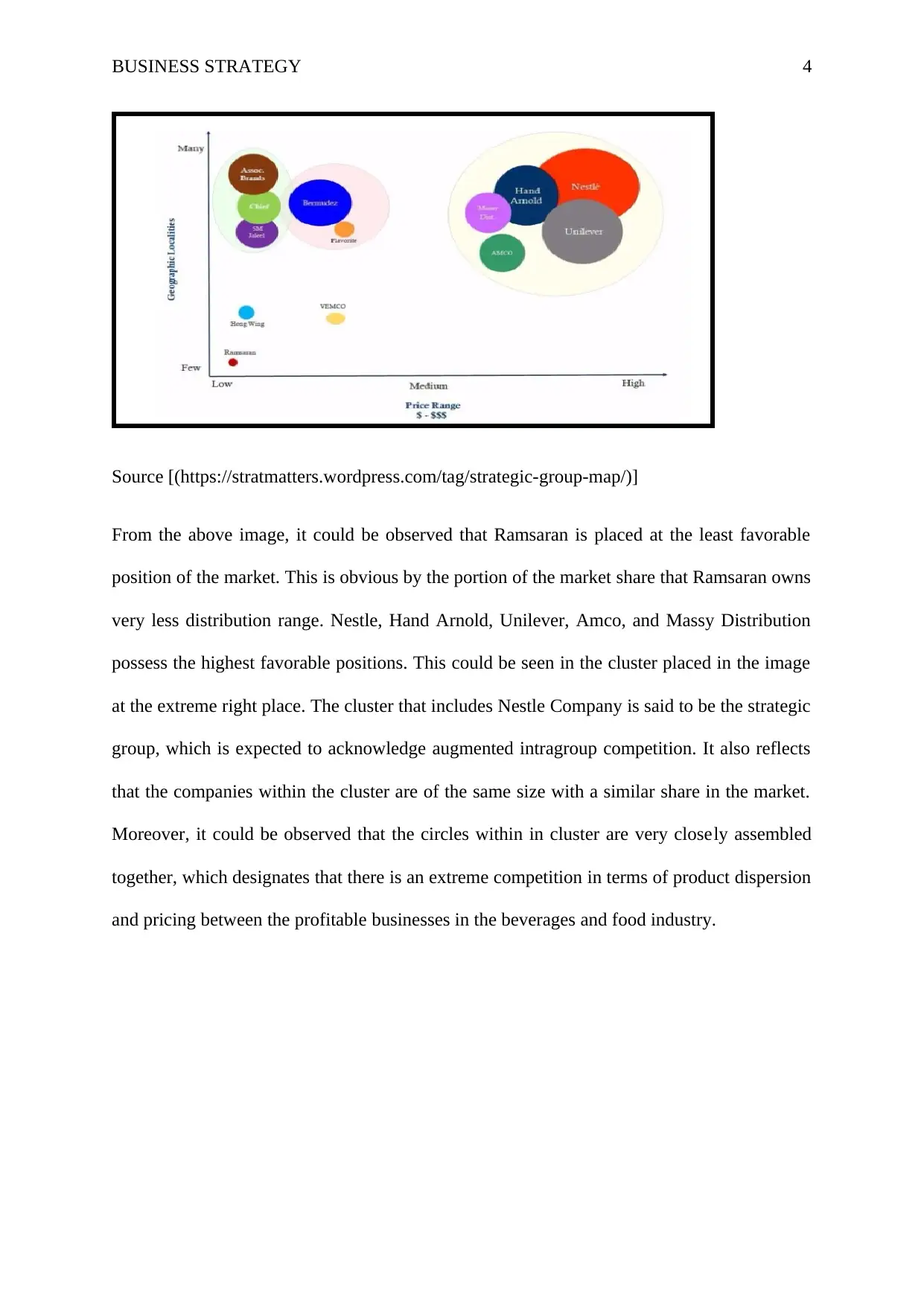
BUSINESS STRATEGY 4
Source [(https://stratmatters.wordpress.com/tag/strategic-group-map/)]
From the above image, it could be observed that Ramsaran is placed at the least favorable
position of the market. This is obvious by the portion of the market share that Ramsaran owns
very less distribution range. Nestle, Hand Arnold, Unilever, Amco, and Massy Distribution
possess the highest favorable positions. This could be seen in the cluster placed in the image
at the extreme right place. The cluster that includes Nestle Company is said to be the strategic
group, which is expected to acknowledge augmented intragroup competition. It also reflects
that the companies within the cluster are of the same size with a similar share in the market.
Moreover, it could be observed that the circles within in cluster are very closely assembled
together, which designates that there is an extreme competition in terms of product dispersion
and pricing between the profitable businesses in the beverages and food industry.
Source [(https://stratmatters.wordpress.com/tag/strategic-group-map/)]
From the above image, it could be observed that Ramsaran is placed at the least favorable
position of the market. This is obvious by the portion of the market share that Ramsaran owns
very less distribution range. Nestle, Hand Arnold, Unilever, Amco, and Massy Distribution
possess the highest favorable positions. This could be seen in the cluster placed in the image
at the extreme right place. The cluster that includes Nestle Company is said to be the strategic
group, which is expected to acknowledge augmented intragroup competition. It also reflects
that the companies within the cluster are of the same size with a similar share in the market.
Moreover, it could be observed that the circles within in cluster are very closely assembled
together, which designates that there is an extreme competition in terms of product dispersion
and pricing between the profitable businesses in the beverages and food industry.
Paraphrase This Document
Need a fresh take? Get an instant paraphrase of this document with our AI Paraphraser
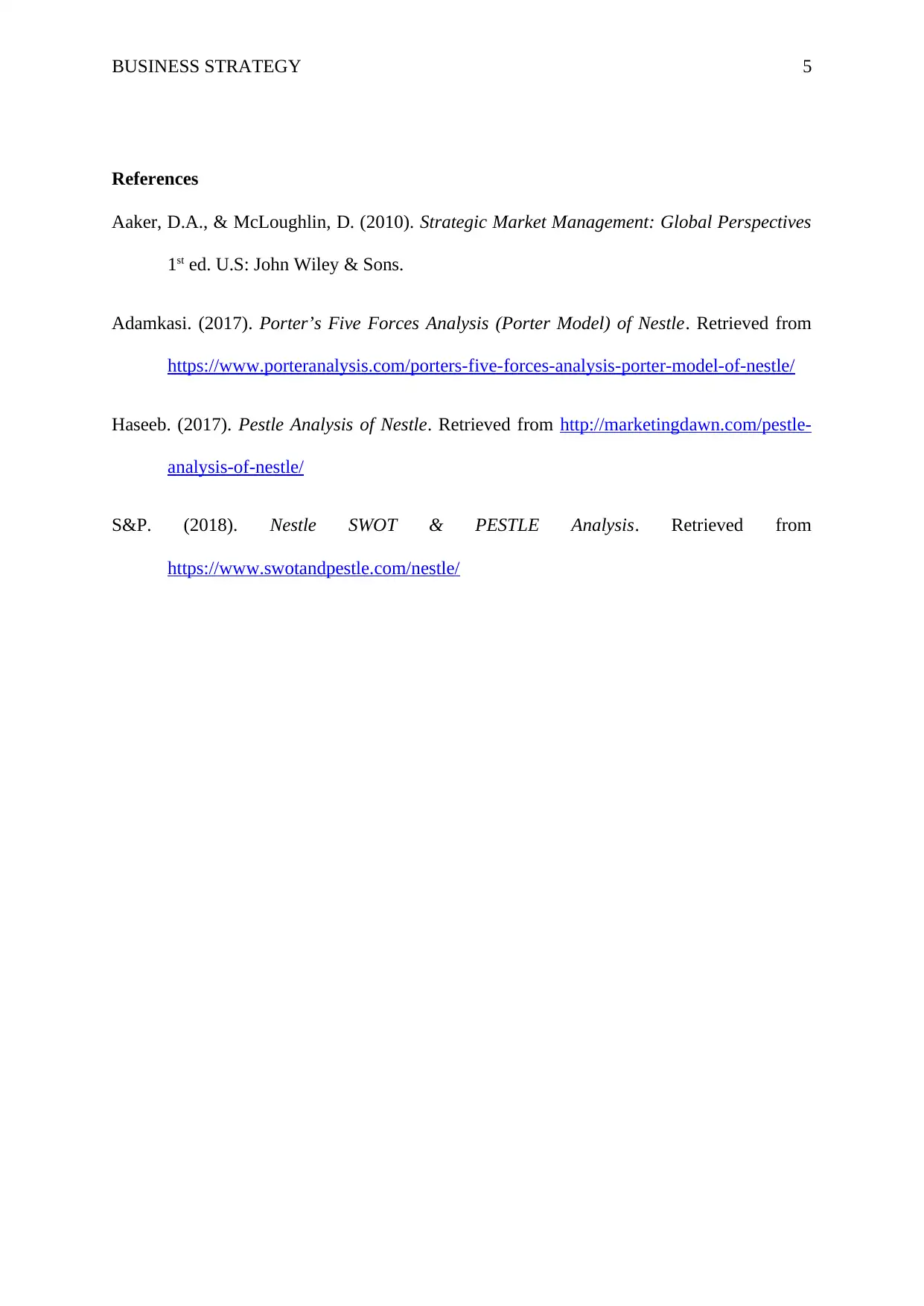
BUSINESS STRATEGY 5
References
Aaker, D.A., & McLoughlin, D. (2010). Strategic Market Management: Global Perspectives
1st ed. U.S: John Wiley & Sons.
Adamkasi. (2017). Porter’s Five Forces Analysis (Porter Model) of Nestle. Retrieved from
https://www.porteranalysis.com/porters-five-forces-analysis-porter-model-of-nestle/
Haseeb. (2017). Pestle Analysis of Nestle. Retrieved from http://marketingdawn.com/pestle-
analysis-of-nestle/
S&P. (2018). Nestle SWOT & PESTLE Analysis. Retrieved from
https://www.swotandpestle.com/nestle/
References
Aaker, D.A., & McLoughlin, D. (2010). Strategic Market Management: Global Perspectives
1st ed. U.S: John Wiley & Sons.
Adamkasi. (2017). Porter’s Five Forces Analysis (Porter Model) of Nestle. Retrieved from
https://www.porteranalysis.com/porters-five-forces-analysis-porter-model-of-nestle/
Haseeb. (2017). Pestle Analysis of Nestle. Retrieved from http://marketingdawn.com/pestle-
analysis-of-nestle/
S&P. (2018). Nestle SWOT & PESTLE Analysis. Retrieved from
https://www.swotandpestle.com/nestle/
1 out of 5
Related Documents
Your All-in-One AI-Powered Toolkit for Academic Success.
+13062052269
info@desklib.com
Available 24*7 on WhatsApp / Email
![[object Object]](/_next/static/media/star-bottom.7253800d.svg)
Unlock your academic potential
Copyright © 2020–2025 A2Z Services. All Rights Reserved. Developed and managed by ZUCOL.





